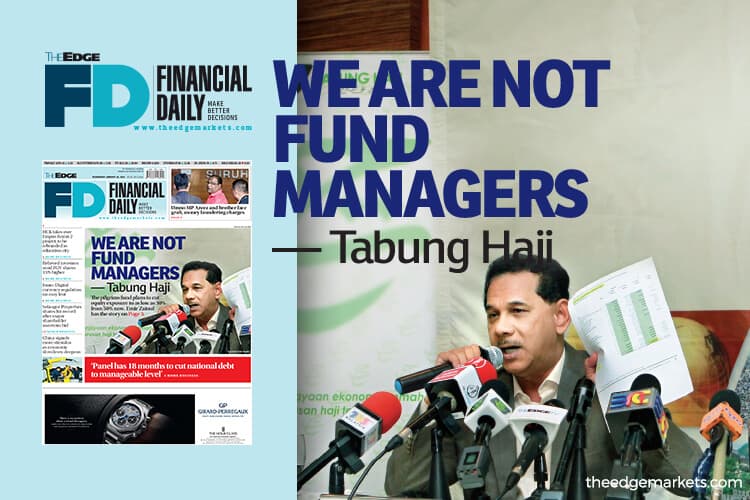
This article first appeared in The Edge Financial Daily on January 16, 2019
KUALA LUMPUR: Lembaga Tabung Haji, which has been one of the biggest casualties of the volatile equity market, is lowering its appetite for risk this year by trimming its exposure to equities in favour of fixed income.
The troubled pilgrims fund, which currently invests about 50% of its multi-asset portfolio in local equities, is targeting to trim its exposure to just 30% to 40%, said its group managing director and chief executive officer (CEO) Datuk Seri Zukri Samat. He did not give a time frame.
While the move is still subject to board approval, Zukri said Tabung Haji has taken cognisance of the fact that it is not a fund manager. “We are not fund managers. Our role is basically to administer the haj, so the focus of investment should change. I think the focus now will be more on fixed income rather than equities,” he told a media briefing on the fund’s corporate turnaround progress yesterday.
The fund's equity market exposure has fallen from 55% of its assets in 2016 to 50% in 2017, but Zukri said the ratio remains too high from his perspective. “It’s not that we are no longer going to invest in equities, but we will tip the balance towards fixed income where we will have a steady stream of returns," he said.
“We have not tabled the new asset allocation to the board yet, but as the CEO, I can personally say that we should have 60% to 70% of our assets in fixed income, depending on the fund size that we have [after dividend distribution],” he added.
The move would mark a sharp realignment of Tabung Haji’s asset allocation strategy, which had been equity-heavy in recent years. In 2016, approximately half of its RM65 billion in assets were in the stock market, with about a quarter in fixed income and the remaining 20% in cash holdings.
Equities are typically seen as yielding more investment returns but also carry more risks due to its volatility, while fixed income such as bonds are less risky but also give less returns.
Meanwhile, Tabung Haji has completed the transfer of all its underperforming equities to special-purpose vehicle Urusharta Jamaah Sdn Bhd as at Dec 30, 2018. The transfer, which began in early December, aimed to close the gap between the fund’s assets and its liabilities as it cannot legally pay “hibah” (equivalent to dividends) to its depositors if it has more liabilities than assets.
Hibah to resume
With the completion of the transfer, Zukri said Tabung Haji has achieved its objective and can now “legally” pay hibah for 2018. “For 2018, we will be legally capable — based on the Act (Tabung Haji Act 1995) — of declaring hibah. But please, don’t expect too much for 2018 because we just recovered from a ‘fever’,” he quickly added.
Last month, the Pakatan Harapan government revealed that Tabung Haji had been illegally paying dividends to its depositors since 2014. The dividend payments had contravened the Tabung Haji Act 1995 as Tabung Haji had more debts than assets in the previous years. Tabung Haji’s 2017 financial report showed that its liabilities stood at RM74.4 billion compared with total assets of RM70.3 billion. This meant a total deficit of RM4.1 billion as of Dec 31, 2017.
When the asset transfer began, Tabung Haji only had 80 sen in assets for every RM1 in liabilities but the gap has now been successfully closed, said Zukri. As at Dec 31, 2018, he said Tabung Haji’s assets is equal or slightly more than its liabilities. The Tabung Haji Act 1995 specifically states that the pilgrims fund cannot declare hibah to its depositors if it does not fulfil two conditions: its assets cannot be less than its liabilities and there must be distributable profits.
Similar to Danaharta Nasional Bhd, Urusharta Jamaah was set up by the finance ministry to take over RM19.9 billion worth of Tabung Haji’s underperforming properties and equities in exchange for a RM10 billion, seven-year sukuk and RM9.9 billion in Islamic redeemable convertible preference shares. Four-fifths of the transferred assets are equities that had declined by at least 20% in value or had seen significant impairment, while the remaining 20% of the transferred assets constitute properties generating less than 2% in annual yield.
Zukri revealed that of the 106 listed local equities that Tabung Haji had transferred to Urusharta Jamaah, the highest unrealised investment loss was 96.5%. He did not disclose the stock name. He added that the fund's top 10 biggest losers accounted for almost RM4.6 billion of unrealised losses, which were mainly in the plantation, oil and gas, property and construction sectors.However, Zukri declined to disclose Tabung Haji’s total unrealised losses from the underperforming equity holdings.
On the 29 properties and land it has transferred to the SPV, 18 generate zero income and are mainly vacant lands. “These assets are not liquid and not in line with our new liquidity framework,” said Zukri. One of the properties in question was the piece of land in the Tun Razak Exchange that Tabung Haji had bought from 1Malaysia Development Bhd for RM188.5 million in 2015, which Zukri said the pilgrims fund had sold back to the government at an undisclosed premium.